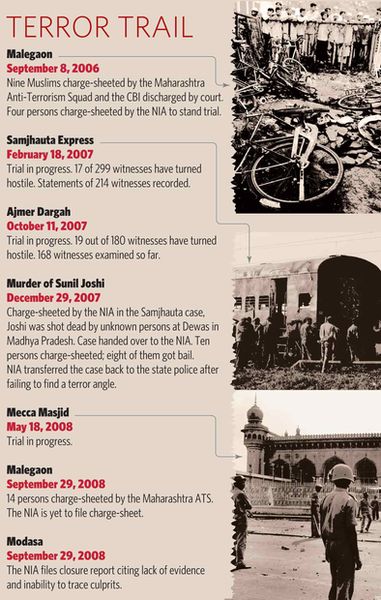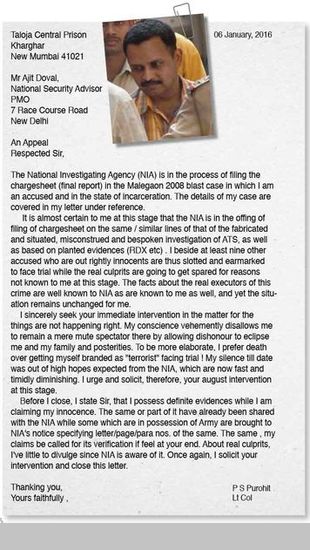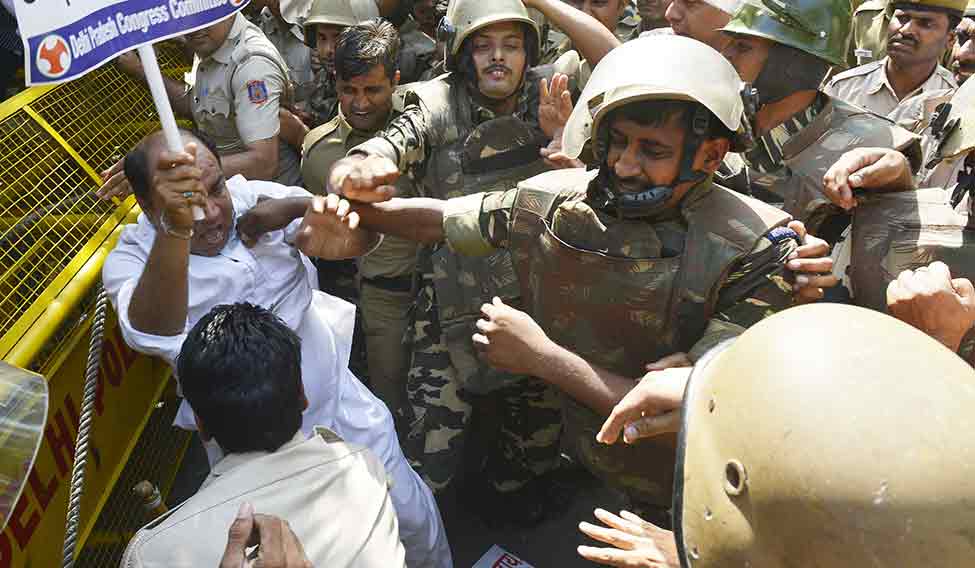On September 15, 2011, the 46th session of the annual All-India Director General of Police Conference took place behind closed doors in Delhi. As was the drill, India’s top police officers discussed the internal security situation, weighing in on threats from the usual suspects: the Maoists, the Lashkar-e-Taiba, the Hizbul Mujahideen, the Students Islamic Movement of India, the Babbar Khalsa International and so on.
Intelligence officers present at the meeting had one thing to add to the list of worries. “Right-wing Hindu organisations have been espousing emotive issues, leading to radicalisation and the phenomenon of saffron terrorism,” warned a special director of the Intelligence Bureau. “Hindu activists are either under suspicion or under investigation in 16 incidents of bomb blasts in the country.”

The same year, the Union home ministry asked the National Investigation Agency to inquire into the alleged involvement of right-wing extremists in six terror cases and one murder case (see graphics). The terror cases were related to blasts in Samjhauta Express in Haryana (2007), Malegaon in Maharashtra (2006 and 2008), Ajmer Dargah in Rajasthan (2007), Modasa in Gujarat (2008) and Mecca Masjid in Hyderabad (2008). The investigators suspected that right-wing extremists were on a mission to build a Hindu nation by paying back jihadis in their own coin. And the term ‘saffron terror’ began gaining currency.
Nearly five years since, the threat perception of saffron terror has undergone a sea change. “There is no saffron terror threat in the country,” NIA director-general Sharad Kumar told THE WEEK. “Since 2008, there has been no activity that has come to the notice of the agency. Hence, there is no question of any threat.”
Kumar’s statement is in keeping with the crumbling prosecution in saffron terror cases in the country. Sample this: 17 of 299 witnesses in the Samjhauta Express case and 19 of 180 witnesses in the Ajmer Dargah case have turned hostile; the Modasa blast case has been closed by the NIA, citing lack of evidence; and three key conspirators—Ramchandra Kalsangra alias Ramji, Sandeep Dange alias Parmanand and Ashwini Chouhan alias Amit—are still at large.
Last year, the Union home ministry declined permission to challenge the bail granted to two of the accused in the Ajmer Dargah case, Devender Gupta and Lokesh Sharma. The ministry said the decision was taken on “grounds of parity”—bail was granted to two other accused in the same case in 2013, and their bail plea was not challenged by the prosecution. The NIA chose not to oppose the bail granted to Swami Aseemanand in the Samjhauta Express case.
 Claiming his innocence: Text of Purohit's letter to Ajit Doval; (inset) Purohit.
Claiming his innocence: Text of Purohit's letter to Ajit Doval; (inset) Purohit.
Lieutenant Colonel Prasad Srikant Purohit, alleged to be the main conspirator of the 2008 Malegaon blasts, recently wrote to National Security Adviser Ajit Doval that he was falsely implicated in the case. He asked Doval to intervene on his behalf immediately, as the NIA was preparing to file its charge-sheet soon. Home Secretary Rajiv Mehrishi has sought the NIA’s response in the matter.
Sharad Kumar’s view that the threat from saffron terror is nonexistent has sparked a debate on whether India’s internal security threat perception is being determined by the government of the day. Former special public prosecutor Rohini Salian had said Suhas Warke, a superintendent of police in the NIA, had asked her to “go soft” on the accused in the Malegaon blasts case after the BJP came to power in 2014.
The Congress has demanded that all cases being handled by the NIA be monitored by the Supreme Court to ensure that there was “no pressure” on the agency. “Whether it is SIMI or Abhinav Bharat, the investigations need to be done without any interference,” said Congress spokesman Ajoy Kumar. “But why is the Modi government so nervous? It is because if Aseemanand or Purohit are convicted, they would start singing and the facts of the case would come out, reaching right at the doorstep of the RSS top brass.”
N.R. Vasan, former NIA special director-general, said the agency was going the CBI way, in the sense that the NIA did not have the skill set to probe critical cases. According to him, the agency is being filled with officers coming on deputation from paramilitary forces like the Border Security Force, which has virtually no experience in investigating terror cases.
“So much is being said about witnesses turning hostile in cases being probed by the NIA,” said Vasan. “If majority of the witnesses are friends or family members of the accused, they are bound to turn hostile after a given time. It is here where the experience of the agency sleuths comes handy and they gather enough evidence that can stand the test of time.”
Former home secretary G.K. Pillai, under whose tenure the home ministry handed over the saffron terror cases to the NIA, defended the agency. “I think the NIA is working professionally,” he told THE WEEK. “The investigations of the NIA have been excellent. If you see the records, the conviction rate of the agency is very high.”






